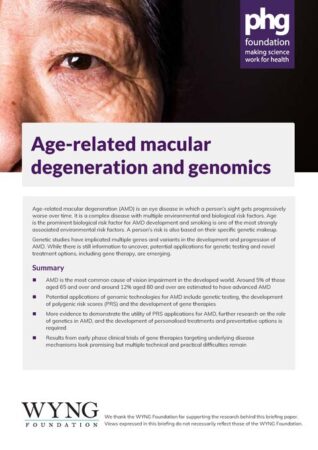Age-related macular degeneration (AMD) is one of the leading causes of vision loss for people aged 50 and over. There is not available treatment for the most common form of AMD. Treatments available for the most severe form of AMD have been revolutionary but for one in three patients they do not work. These people are left with limited options. In our recent policy briefing, Age-related macular degeneration and genomics, we outline potential applications of genomic technologies for the prevention, diagnosis and management of AMD, as well as a brief description of AMD. Below, we examine the prospects for gene therapy for AMD.
AMD is a complex disease as the risk of development is due to environmental and biological factors. There are two main types: dry and wet. The latter is more severe with vision loss occurring rapidly. Dry AMD accounts for around 90% of AMD cases and usually precedes the development of wet AMD. Inflammation has been implicated in both types of AMD, however, wet AMD is also characterised by an overgrowth of blood vessels.
Treatment for AMD was transformed by the development of drugs that stop blood vessel formation. Yet, these treatments are not effective in some patients and are not applicable to those with dry AMD, who make up the largest proportion of sufferers. There isn’t any treatment for dry AMD aside from tools to help people see better (e.g. magnifying glasses).
The role of genetics in AMD
Genetic testing for those with AMD is not recommended by many professional organisations around the world. This is in part due to the complexity of the role of genetic in disease development and progression. Until recently, there has also been a lack of treatment options based on patients’ genetic profiles. This is beginning to change as the understanding of AMD genetics is rapidly improving. Novel therapies such as gene therapy are becoming available, some of which are tailored to a subset of individuals with specific genetic defects.
Evidence is mounting that a patient’s genetic profile may influence how effective treatment is. Additionally, some therapeutics are being developed that target pathways where specific genes are implicated, therefore, genetic testing is becoming a prerequisite for some treatments in clinical trials. The fast pace of progress in this area may soon prompt a re-examination of the current guidelines and recommendations for genetic testing in AMD.
Gene therapy for AMD
Gene therapies for AMD target the biological pathways that lead to disease. They are designed to deliver genes involved in reducing new blood vessel formation, or those that control inflammation. There are several gene therapies in clinical trials for both types of AMD. Two of those are specifically for patients with dry AMD, who carry variants in genes known to be important in disease development.
GEM103 is a gene therapy by Gemini Therapeutics that was recently granted Fast Track designation by the FDA. Patients are eligible to take part in the phase 2a clinical trial for this therapy if they have a genetic variant in their Complement Factor H (CFH) gene that causes it to lose its function. GEM103 delivers a healthy version of the CFH gene to cells in the macular, enabling them to make a working version of the CFH protein. The CFH protein is essential for protecting healthy cells from inflammation. If it is not working properly cells will become damaged. Extensive research efforts over the past decade have confirmed that complement dysfunction is a key pathway in AMD pathogenesis and around 40% of AMD patients carry a mutation in the CFH gene.
Another genetically targeted gene therapy, GT005 by Gyroscope Therapeutics, was also granted Fast Track designation by the FDA in September last year. GT005 delivers the gene Complement Factor I (CFI), which has a similar function to CFH. An added benefit of GT005 gene therapy is that it is a one-time injection into the retina, as opposed to GEM103 which may require monthly injections.
Time to re-examine recommendations on genetic testing for AMD?
A multifactorial disease like AMD will warrant a combination of treatment options tailored to individuals. The two targeted gene therapies discussed here are likely to be the first in a wave of new treatments for AMD guided by genetics. Genetic testing of AMD patients will become essential to ensure that all patients have equal access to these personalised therapies. This requires careful consideration of the current guidelines and recommendations in place for managing those with AMD. Questions to be resolved include: how genetic testing might fit in the patient pathway, whether there are other biomarkers that could be a surrogate for genetic information, and how family members might be implicated by the results.
Moving towards a brighter future
There are still technical limitations and challenges for gene therapies, however, results from prospective clinical trials are promising. Alongside other novel therapeutic options such as stem cell therapies, gene therapy holds new hope for AMD patients. If successful they will be beneficial to patients for whom no current therapies are available or do not work.
Tailoring treatment is just one potential application of genetic testing for patients with AMD. It is likely that in future, predictions will be made about who is at risk of developing AMD and what type, using information about individuals’ genetics. This may then allow for personalised preventative interventions to be employed. We explore the applications for genomic technologies further in our recent policy briefing.

